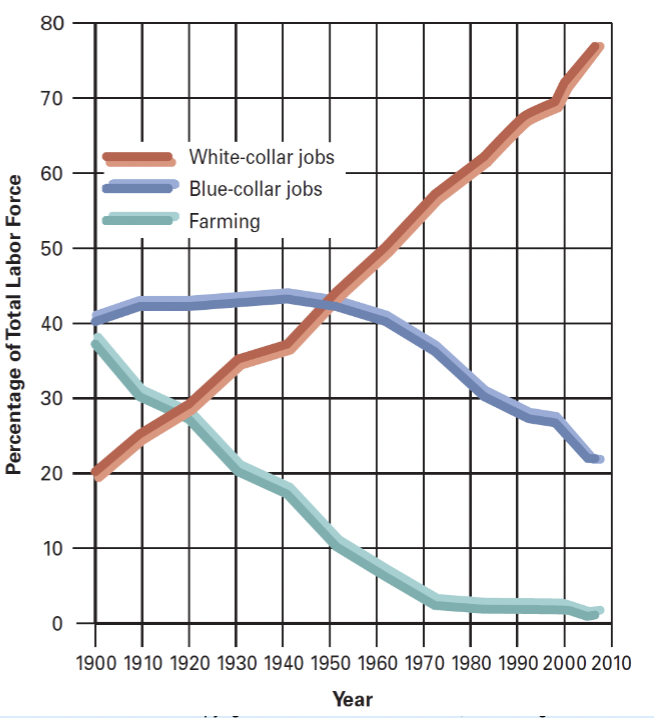Economy and Work
Various economic factors help understand a society’s production, distribution, and consumption of goods and services.
The economy is unpredictable
Goods: These are tangible items produced for sale, ranging from necessities to luxury items
Services: These are intangible activities or benefits provided to consumers, including healthcare, education, and entertainment, that benefit others
Revolutions:
Agricultural Revolution:
The earliest societies were hunters and gatherers with no distinct economy
Four factors that made the economy a distinct social institution:
Agricultural technology
Job specialization
Permanent settlements
Trade
The Industrial Revolution:
New sources of energy
Steam-fueled machine operation
Centralization of work in factories
Mass production techniques
Growth of urban populations
Shift from agrarian to industrial labor patterns
Impersonal factories replaced cottage industries
Manufacturing and mass production:
Turning raw materials into a wide range of products
This shift has led to increased efficiency and lower costs, but it has also contributed to the decline of traditional craftsmanship and small-scale production.
Specialization:
A diverse division of labor has emerged, allowing workers to focus on specific tasks, lowering overall skill requirements
Wage labor:
Working for a wage has become the norm in many sectors, where individuals have intense supervision
Post Industrial Society (The Information Revolution):
Postindustrial economy: A productive system based on technology and services rather than manufacturing, characterized by a shift towards knowledge-based jobs and the reliance on information technology
This information revolution has altered the fundamental character of work in three ways:
From tangible goods to intangible services
The emphasis now lies on providing experiences and solutions that cater to consumer needs
From mechanical skills to literacy skills
Enable individuals to adapt to new technologies and processes, fostering a more knowledgeable workforce.
From factories to almost anywhere
The landscape of work is shifting towards flexibility and remote opportunities
Sectors of the Economy:
Primary sector:
Generates raw materials from the environment through activities such as agriculture, mining, and forestry, serving as the foundation for all other sectors
Secondary Sector:
Transforms raw materials into manufactured goods through processes like manufacturing and construction, adding value and creating products for consumers and businesses
Tertiary Sector:
Generates services rather than goods, focusing on providing support and assistance to individuals and organizations, such as retail, healthcare, and hospitality.

This graph shows the shifting structure of the American labor force from 1900 to 2010. It reflects the sociological transformations related to industrialization, urbanization, and post-industrial society.
The end of the agrarian society (Farming is no longer the backbone of the economy)
After WWII, the U.S. had a significant increase in manufacturing jobs, which contributed to the growth of the middle class and a rise in consumer culture
The Global Economy
Expanding economic alliances and trade agreements have further interconnected national markets with little regard to national borders, leading to both opportunities for businesses and challenges related to job security and workforce displacement
Five major consequences:
Global division of labor has emerged (enabling specialization and efficiency but also contributing to the outsourcing of jobs from developed to developing countries)
Products pass through many nations in the supply chain, often resulting in lower production costs; this can disrupt local economies and increase dependence on foreign markets
National governments no longer control the economic activity within their borders (challenges in regulatory standards and tax policies)
A small number of businesses now control a vast share of the world’s wealth (leading to growing inequality, which leads to instability and social unrest)
Raises concerns about the rights and opportunities of workers (as these large corporations often prioritize profit over fair labor practices, undermining job security and fair wages for employees globally)
Capitalism:
An economic system in which resources and the means of producing goods and services are privately owned
Individualistic Approach
“Justice” amounts to marketplace freedom and opportunity
“Freedom to” (opportunity)
Three distinct features:
Private ownership of property (promotes individual initiative and encourages investment, leading to economic growth and innovation)
Pursuit of personal profit (drives competition and efficiency, as individuals and businesses strive to meet consumer demands and improve productivity)
Competition and consumer choice (empower consumers by providing them with various options, fostering a dynamic marketplace where businesses must continually adapt to maintain market share)
Socialism:
An economic system in which resources and the means of production are collectively owned (The State)
“Justice in a socialist context means ensuring that wealth and resources are distributed among the population
“Freedom from” (promoting an essential society where everyone's basic needs are met)
Three distinct features:
Collective ownership of property (enables communities to manage their means of production collectively)
Pursuit of collective goals (promotes collaboration and shared responsibility among community members)
Government control of the economy (ensures that resources are allocated in a way that benefits the whole community, rather than individual profit)
Capitalism vs. Socialism:
Economic productivity?
Average GDP is $13,500 → Capitalist countries usually produce more wealth (higher GDP = more goods and services)
Average GDP is $5,000 → Smaller gaps between rich and poor. Wealth is more evenly spread
Economic equality?
More income disparity → Big gaps between rich and poor. Some are very rich, others stay poor.
Less income disparity → Smaller gaps between rich and poor. Wealth is more evenly spread
Personal Freedom?
Freedom to pursue personal self-interest → You have the freedom to do what you want (start a business, search as much as you can)
Freedom from basic want → The focus on making sure everyone’s basic needs are met (food, shelter, healthcare)
Capitalism gives more individual freedom and more wealth, but with bigger inequality
Socialism gives more equality and basic needs security, but with less total wealth and fewer choices
So far, no system perfectly balances being super free and super equal at the same time
There is more convergence, the United States is exploring systems that consider both capitalism and socialism to address these disparities